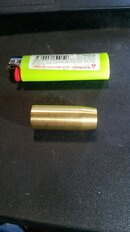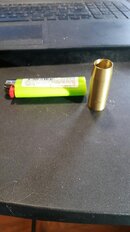Before I start. You should gently remind
@iain/hsm to show you and explain the piston storage tube for the third stage. If it is anything like the one I had (for the 4VX's 4th stage) it is very important and helps a lot getting that floating piston and all those rings back in the bore hole!
I believe that Iain stated it pretty clearly when he said: "One of our extreme tests was to submerge the compressor block only underwater by hanging on its side by a hook then pull it out attach the power cable and start up with some small additional no tool hand adjustments such as opening the condensate drains and turning the compressor by hand before re starting."
There is a huge gulf between what you can do and what you should do. Also add in liability and the stupid factor e.g. Iain told me that I could take the compressor underwater. LOL
When I was a young welder I wanted to fill my smaller 25 Cu.Ft. Oxygen cylinders and the cost per fill was 3/4 of a 200 Cu.Ft. Cylinder. So I went to the local Hydraulic Hose manufacture and purchased a 6' (2 METER lol) 10,000 PSI hose for OIL. I purchased 2 CGA 540 nipple and nut and have trans-filled many O2 cylinders. This hose was neither made or meant for Oxygen service!!!
Back to the show!
On my 4v compressor, in the original data my compressor was designated a Nitrox compressor. So when I ordered parts from RIX they had 2 part numbers one was normal and the other was O2 cleaned. The second was quite a bit more expensive (and more time)! So I ordered the standard part and I cleaned it. I unfortunately did not know that Iain was probably here on the forum all along. I had NO advice other than RIX. I purchased chemicals from GMC, Global Manufacturing Company (Now GSM Global Scuba Mfg out of Texas). I used ultrasonic cleaning solution to thoroughly clean the part then use Oxy safe citrate tank cleaner #44050 to re-clean the parts but also the new: orings, rider rings, pressure breakers and the pressure rings. Never touched the cylinder liners (Usually. See follow up) thoroughly dried them of course and re-assembled in the cleanest way possible! I am by no way saying that this is the correct way to do it and I am sure we will hear Great things from Iain tomorrow about this. But, I had no problems with cleaning the PTFE parts with a citrate cleaning solution meant for tanks and valves.
Where was I going with this???? Oh yes.... Things you probably, maybe, outa, shouldn't do! (like taking your compressor diving! I just love that!)LOL
Touching the cylinder:
When I inherited the position and compressor, everyone had been using it like a home appliance and it had not been serviced in a LONG time. They did not even ask themselves: Why does it take all day to fill the banks now? I dug out all of the paperwork. Fortunately for me they saved it all. I contacted the last guy that the shop had work on it and when he showed up in a big diesel service truck with black grease on his hands clear up to his elbows I told him "you can't touch the pistons with grease on your hands" he said "Why not?" I told him I would do it myself! When I removed that 4th stage piston for the first time. The rings were gone. GONE! some of the orings to! Pressure breakers gone! I replaced them all and they wore out rather quickly. After many telephone conversations with (Rick Stolquist If memory serves and Christina Torncasa in purchasing) I was informed that running the free floating piston with insufficient rings will allow the piston to slop around in the cylinder and cause wash boarding of the cylinder walls. I was told to hold the cylinder up to a bright light (My cylinders were removable) that you could see the wash boarding. Yep. That is what happened. Then I was informed that a new cylinder was $2500, + shipping and I had to wait for one to be manufactured! I read the manual from cover to cover and it was one of those field service manuals Iain talks about. It stated that if you measure the bore and it was within tolerance that you could hone the cylinder! WOW field repair! Now I have honed automotive cylinders but this a precise instrument? (A good time to mention that the liners of the 4V are not removable) So I purchased a 1200 grit ball hone, it was not long enough. build extension. But what about the oil? You have to use LOTS of oil and what of the steel, stone and oil left behind? Well I called my longtime hotrod mechanic friend Bill McFeeters and he said: "I put mine in the dishwasher"! So this delicate instrument was field honed with lots of oil, dishwashered (Is that a word?) and reassembled after lots of O2 cleaning and it worked perfect till the day I replaced the whole compressor. (Very sad day)
By the way. RIX told me over the phone that I could not do it. It was not part of the specifications! I did it.
So to end. Like Iain said, Don't touch it or do it right!!!
Wow this went long! I can not wait to see the replies!





